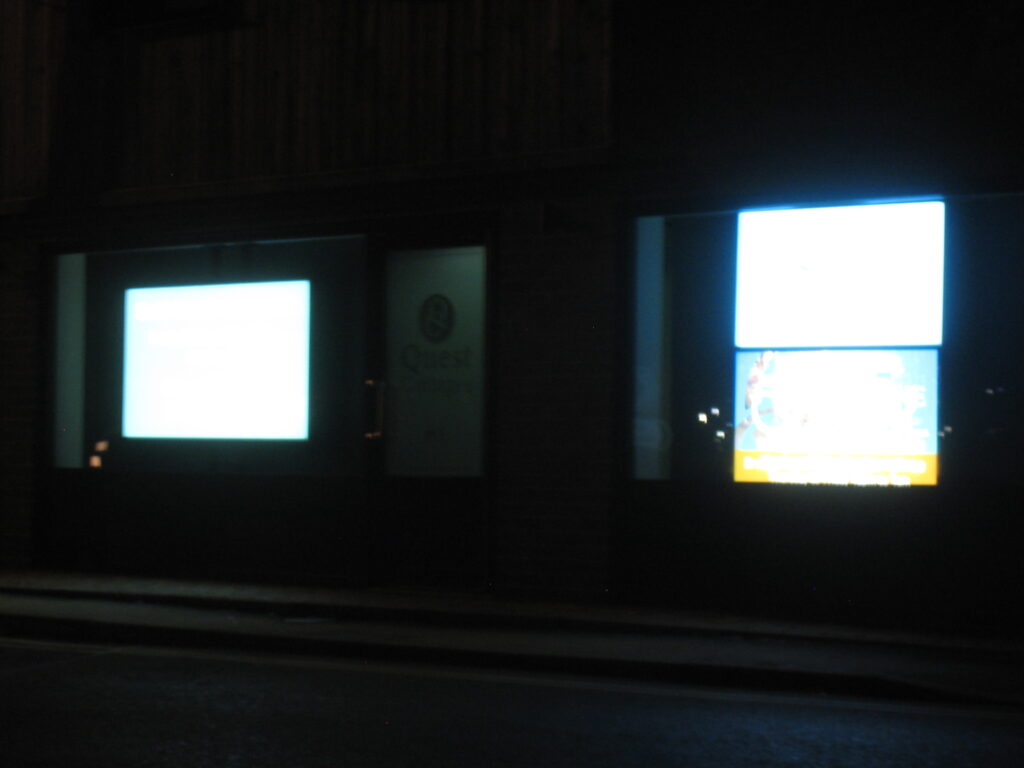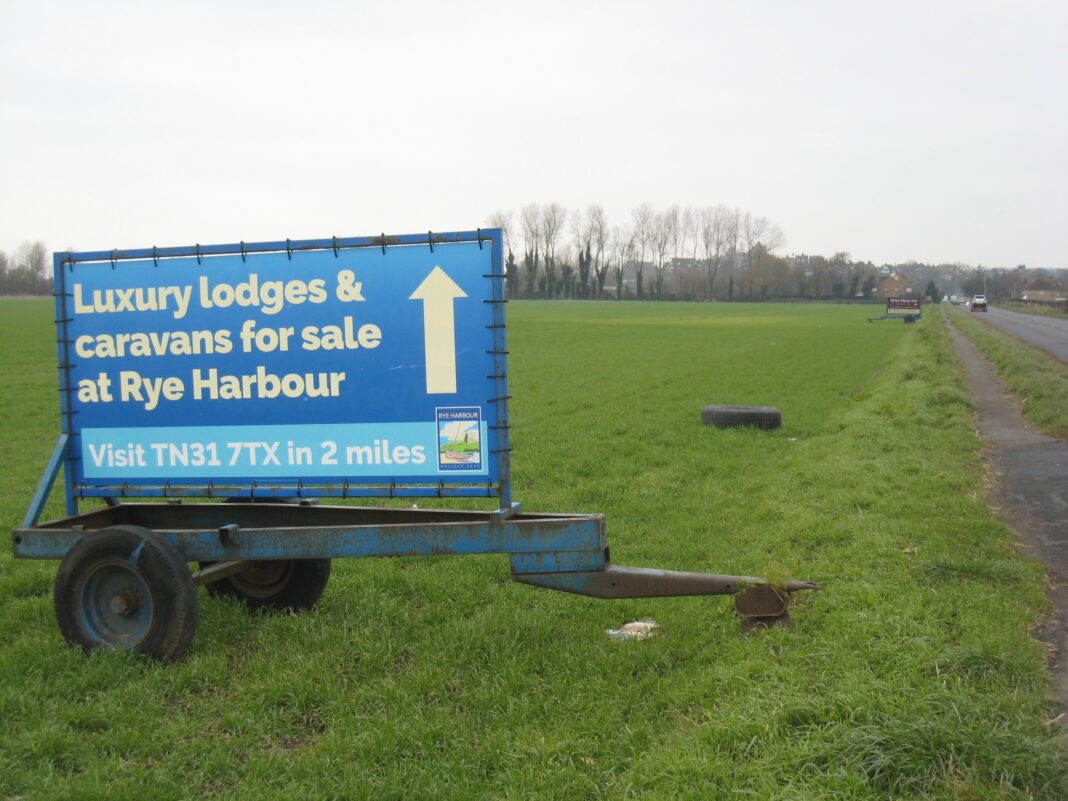Rye residents and visitors cannot fail to have noticed the three large advertising monitors in the window of a newly installed business at the A259, Fishmarket Road roundabout.
A question many people are asking is whether these bright screens are allowed in Rye and if planning permission has been given for them. If not, why is Rother District Council allowing the screens to remain? Where, if anywhere, does Rye Town Council stand on this challenge to the town’s historic identity?
In the first instance, one should point out that if permission has indeed been given, or “deemed consent” applies, any complaint about the screens appears rather futile. One might wish good luck to the company concerned. However, if consent has been granted, the planning precedent will mean that every storefront, office and business premises in Rye will be able to display large advertising video monitors in their windows. For a historic town such as ours, this would surely represent the death knell for its vital tourism offering. Rye would soon look more like a miniature Las Vegas.
Astonishingly, for several months the roundabout colour screens have been operating 24 hours a day, seven days a week in a largely uncommercial area of low footfall. The only real targets for this advertising are vehicles using the roundabout itself, with drivers at risk of being distracted by the screens. At night, the glowing monitors are especially out-of-keeping with Rye’s historic character. It’s unclear what view East Sussex County Council’s roads and transport division has on these screens — if indeed they know anything about them.

Several years ago, when BP proposed, unsuccessfully, building a service station at the top of Udimore Road, the local community’s arguments against intrusive illumination and the impact on the character and appearance of the area carried great weight.
A thriving business community is the lifeblood of small towns, but some people would argue that councils — both district and town — often have a blind spot when it comes to enforcing regulations on businesses — even when the law is crystal clear, as it seems to be in this case. Appearances can be deceptive, however: it could be that huge video screens are entirely permitted within the town boundary.
Nevertheless, with regard to the roundabout screens, there are strict rules relating to illuminated advertisements in the Town and Country Planning (Control of Advertisements) (England) Regulations 2007. Adverts displayed inside a building may not be illuminated and must not include any intermittent light source, moving feature or animation. No advertisement can endanger road users, or impair the “visual amenity” of the site. Moreover, the premises in question are reportedly located within the Rye Conservation Area, where illuminated screen advertisements are not permitted.
Another example of advertising that negatively affects Rye’s identity as a visitor attraction relates to the two large, permanent wheeled hoardings at the side of the A259 just outside the Rye town boundary. Visitors (and locals) approaching Rye from the east and expecting to view the ancient town rising majestically on its hill have long been sorely disappointed when their first visual experience of Rye are these intrusive advertising signs.
Given that a huge proportion of advertising has moved online, it’s highly unlikely that such digital screen adverts or large hoardings sell much in any case. All they do is adversely affect the town’s character and give a disappointing impression of Rye’s priorities.
Rather than permitting local residents to lodge informal complaints about potential planning violations, Rother District Council obliges complainants to make a detailed, formal complaint online, which deters residents from complaining. The end-result is anti-democratic, as it restricts public participation in the decision-making process. The length of time it takes to receive a response from the council leads to a tremendous amount of uncertainty over what advertising is allowed and what isn’t.
RDC does have a duty to exercise powers under the Town and Country Planning regulations “in the interests of amenity and public safety”.
Much has been said recently about the need for councils to communicate better with residents in Rye. One thing Rother District Council could do to help its residents would be to identify unapproved advertising and clamp down on it as quickly as possible — before it gets out of control. Where uncertainty exists, the regulations should be communicated to residents so that they know the position.
If anyone from RDC, or elsewhere, can assure Rye people that illuminated screen advertising on a busy roundabout in fact has ‘deemed consent’ or planning permission, I’m sure every business in the town would be grateful to hear from them.
Image Credits: Larry McIntyre .




I too would very much like to know why Rother are not acting on these advertising sites which contravene the relevant Planning Regulations in rather more than one aspect. Having been responsible for the commercial advertising activities of a National public body in the past, I am amazed that the Planning Authority has not acted, and would very much like to learn their reasoning.
Just for clarification Rother Enforcement Officers have been actively dealing with these matters since mid – March, long before this article was written, and substantial progress has been made. I am not going to comment on active casework, but I have been in contact with officers from the outset.
On the subject of on-line reporting this is essential if Rother is to provide an efficient and effective service. It enables workloads to be assessed and is far less resource- intensive than having a telephone reporting system. A good example of the benefits of reporting on-line is a missed refuse collection. If reported on-line this goes straight through to Biffa who can remedy any error the next day. Likewise reporting of other defects.
When in doubt Councillors are here to help you, and I have sometimes filled in the on-line form for a constituent.
In fact Rother has been acting on complaints about both the illuminated and mobile signs. Neither matter is concluded, but residents will note the illuminated signs are now much less bright than before. I can’t say more about current actions, but it’s a pity the author didn’t check this out with Rother before publication.
I would encourage anyone with a planning enforcement complaint to fill in the on-line form. That way complaints are properly logged, workloads assessed and action (where appropriate) taken. It takes a little time and trouble to do it, but officers need the very basic information requested in order to decide what action to take.
What Cllr Mier describes as the ‘mobile signs’ are in fact permanent. Everyone in Rye knows they have been in place for years and no action has been taken to remove them. To claim the roundabout screens are ‘less bright’ as if this is some sort of RDC achievement is laughable, when the Council should clearly have taken rapid enforcement action in this case and ensured the screens were deactivated. Why has a Planning Contravention Notice not been issued? How much longer will drivers be subject to distraction from these screens? One of the problems I’ve noted is actually getting RDC to respond informally and in a timely fashion to enquiries from the public. For example, Rother does not actively publicise the emails of departmental officers, as it seeks to minimise direct contact with residents. Rather, the Council channels most of its planning (and other) public communication via online forms. This makes it very difficult for residents to find out what’s going on. Also, some people may not wish to lodge formal complaints.
With reference to Cllr Mier’s comment regarding the illuminated advertising, then as I recall (and I admit it’s some time ago that I dealt with such matters) the first question is whether the advertising site enjoys Deemed (Planning) Consent. This is clearly defined in Schedule 3 of the Regulations. Illumination levels play no part in determining whether an advertising site enjoys Deemed consent! Although I am not certain of the physical size of the current displays, nor of the actual content displayed, my feeling is that it is unlikely that the current displays fall within that category. That being the case, the normal course of action in my experience would then be for the Planning Authority to invite the owner of the site to apply for Express Consent retrospectively for the display of the advertising. There exist a number of areas in this case where such application would appear likely to fail as it is a sensitive area. Also the Highway Authority would be need to be consulted on matters of road safety. In the case of refusal, the site owner then has right of appeal to the DoE. I have searched Rother’s database of planning applications and cannot find any such application, but perhaps Cllr Mier can point me in the right direction here, as discussion with the site owner has evidently taken place?
The mobile roadside site is another matter altogether, as I recall this technically falls within Class B of Schedule 1. It just happens to be parked there – the same as many towed trailers happen to be parked in other locations. In fact one outdoor advertising company made a successful business at one time from their fleet of towed trailers.
Again, for those interested, here is the link to the appropriate planning regulations:
https://www.legislation.gov.uk/uksi/2007/783/contents
On this occasion I agree with Cllr Mier. Facts first, follow procedures to complain, review actions and follow up if not satisfied. One could also contact your local Rother Councillor – the upcoming elections will hopefully bring some new more proactive blood to RDC
I’d agree that anyone with an enforcement or any other Rother problem should talk to their District Councillor. It’s what we are here for.